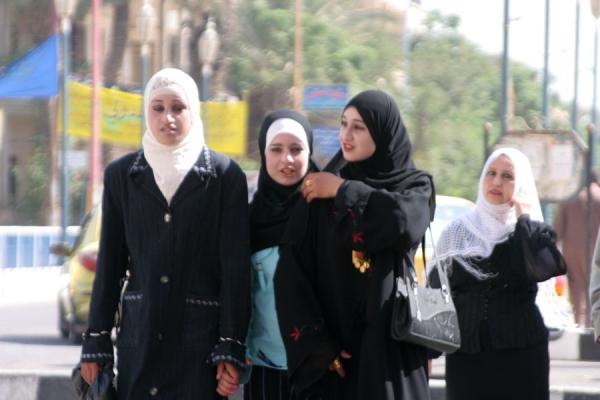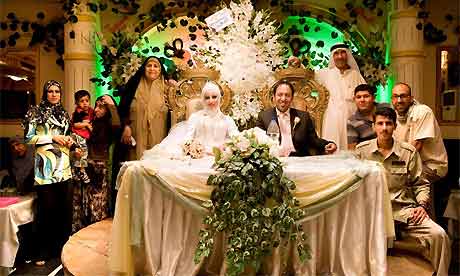In Syria spoken languajes are Arabic, English, French, Kurdic, Circassia and Aramic. In Syria they have many religions. Some include Sunni Muslim, Muslim, Christians, and Jews. Syrians are Islamic. "Islam" means "Submission to God". Syrians share a prophet, traditions, Judism, Christians, and follow the 5 Pillars of Islam. Islam has no priest nor clergy. They have people that lead prayers and the Quran (their holy book). those are called "Muezzins" which give call to prayers and spend their lives studying and interpreting text. have a mpnth called "Ramadan" which is a month of fasting meaning they don't eat until dark outside. In Syria they end the month with "Eid al Fitr" which families exchange gifts. Also have "Eid al-Adha which commemorates the end of Muhammod's Hajj. Muslims house of worship is called Mosque. Mosque has a washing rooms outside, where you can remove shoes and wash your feet etc. before entering. Women can't enter. And when you enter it just has a carpet and a carving pointing at the location where Mecca is. when someone dies family, friends, neighbors, etc. meet for three days after death to give grief to the family. Women who are related to the passed love one wear black up to a year. Widows normally don't remarry and wear black for the rest of their life's.
(Mosque in Syria)
(Classic Arabic Instruments)
Dances in Syria are also amazing and interesting. In Syria they call "dance" "Raks". Syrians have several types of dances. One type of dance is called the line dance and another the cirle dance. In both men and women dance just not together, but in the circle dance they might dance around the circle of woman or the opposite. Another is the women dance which one or more women dance. Another is the men dance in which they battle but dancing. and another includes ceremonial dances.
The etiquette in Syria is most like the same throughout the Middle Eastern. Men and women are seperate unless for special gatherings. Syrians like to talk. Syrians have an art of conversation which you need skill to do. Men talk and also tease each other but in a way of joking. When talking you stand close , speak loudly and gesture with hands and head. Greeting in Syria have a huge significance. Also when greeting someone you shake hands, hug or give a kiss on the cheek. Syrians are also very Affectionate. Both women and men kiss, hug and hold hands with people from the same gender. This is very common in Syria and can be seen mainly in public places.
(Syrian People)
The food in Syria is very delicious. The main crop is wheat, but they also have different types of vegetables, fruits and dairy. Syrians like most Islamic don't eat pork. Syrians mainly eat lamb, but not many people can afford lamb everyday. Syrians prepare other meat's in a Halal cooking. Many middle and higher class eat their meat either grilled or roasted. Syrian also have somthing called Mezzeh which is a midday meal composed of 20-30 side dishes(including hummou, chich peas, tahini, baba ganou, and many more). Syrians use dives, lemon, parsley, onions, garlic, etc to flavor thier food. Syrians grow figs, plums, and watermelon. Syrians also can't drink alcohol. Syrians can drink beer, wine, milk, soda, tea but only in special occations and arak an aniseed drink used in the Middle East. And during Ramadan they eat "ifar" during the evening.
(Syrian food)
Marriages in Syria are arranged by the parents in a way to give blessings to the one's being married. The husband is picked by the family. The constitutions encourages the institution of marriage rate decreased because of levels of education and cost of weddings. Normally the husband and his family raise the money and the bride marries the one with the biggest dowry. In 1953, the law of of Personal staus was passed which was that men must be able to show they can support a second wife to then marry that second wife. And for divorces the man needs to say "I Divorce You" three times then go to court.
(A Syrian Wedding)
Syrian art has three types of art: Graphic Art, Performing Art, and basic Art. Art's are published in houses owned by the state. writting is done by the government employees. They can't write about Syrian history. In graphic art their are no paintings of animals and human being. Sculptures are carved in white marble and displayed in public buildings. Jewelry, metalwork (started by Syrian Jews) and mosaic woodwork are very popular. Syrian also have fabric production. And performing arts which filmwere first produced during the 1920's. And includes story telling and musicals.
(Jewelry from Syria)
Lastly celebrations in Syria. The holidays celebrated in Syria are: New Year's Day on Jan. 1, Revolution Day on Mar. 8, Formation of Arab League on Mar. 22, Martyrs Day on Apr. 6, National Day on Apr. 17, and the Day of Mourning (grief) on Nov. 29.
(Martyrs Day in Syria)
For more info in other websites or articles go to these links: Culture of Syria, Middle Eastern Dances, and Middle Eastern News.







Negara Syiria memiliki cultur budaya yang sangat menarik
ReplyDeleteTerima kasih, atas info anda